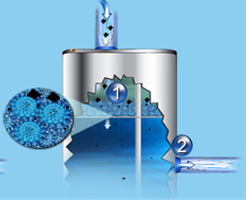
Turbidex™ Media – Clearer Water for Homeowners with Well Water
When you get a glass of water from the tap in your kitchen, how does it look? Is it crystal clear or cloudy?
Your home’s water could be bit cloudy because of air bubbles due to pressure in the pipes or the aerator on your faucet. However, sometimes it’s more than bubbles. If you let a glass of water sit for a few minutes and you still see cloudiness or perhaps some sediment at the bottom, you may have water with high turbidity.
What is Turbidity?
Turbidity is a measure of the cloudiness or haziness of water caused by suspended particles, and it is an important factor in determining water quality. It’s basically tiny bits of rock, soil, and other matter floating around in your water.
This can be aesthetically unpleasing and it may affect the taste of drinking water, but it could also pose a health risk. The United States Geological Survey (USGS) says turbidity may cause stomach issues as it can be a breeding ground for bacteria.
“Turbidity can provide food and shelter for pathogens. If not removed, turbidity can promote regrowth of pathogens in the distribution system, leading to waterborne disease outbreaks, which have caused significant cases of gastroenteritis throughout the United States and the world.”
Because homeowners with private wells access groundwater, they’re more likely to experience issues with turbidity. Well water isn’t treated by a municipality before entering the home, which is why homeowners with wells usually need water treatment equipment like water softeners and filtration.
The problem is that typical resin media used in water softening is not intended to remove turbidity. Water softeners reduce hard minerals like calcium and magnesium, but they do not efficiently remove suspended particles. For that, you’ll need additional filtration.
Turbidity vs. TDS
Another term you may hear water treatment professionals use is total dissolved solids, or TDS. Turbidity and TDS differ in an important way.
TDS is a measure of dissolved or soluble solids, which you can’t see with the naked eye, and turbidity looks at the haziness of water caused by suspended solids. So, turbidity measures insoluble matter in your water, the stuff that does not completely dissolve.
The reason turbidity creates a risk for bacterial contamination is that it gives pathogens a place to hide. In fact, high turbidity may even impact the effectiveness of water treatment solutions like ultraviolet purification systems.
When you call a Water-Right dealer for a free in-home consultation, you’ll learn more about the turbidity and TDS levels in your home’s water.
How Turbidex™ Media Solves the Turbidity Problem
Water-Right recently became the sole distributor of a unique water treatment media known as Turbidex™. It is often used in commercial and industrial setting, but Turbidex™ can also be useful in certain residential situations.
Water softeners use a specific media in the ion exchange process, which swaps out sodium for the calcium and magnesium that cause hardness. (Learn more about how water softeners work.) That’s usually where it ends when typical resins are used. Water-Right has access to media that takes things further.
Our exclusive, Crystal-Right™ media is ideal for treating well water because it not only softens water, it also works to filter out iron and manganese and reduce pH levels. However, it’s not as effective as Turbidex™ at addressing turbidity. Both Crystal-Right™ and Turbidex™ have unique properties that give them specific advantages. When both media are applied to a homeowner’s well water, it can provide a result that is softened, clear, and clean.

How Turbidex Works
Granules of Turbidex™ have microscopic pores that capture the suspended particles and remove them from the water. Typical filtration media removes particles between 12 and 30 microns. Turbidex™ can filter down to as small as 3 to 5 microns, providing better quality water.
If you’re using a reverse osmosis system (RO) for your drinking water, Turbidex™ can help protect that investment and make sure the RO keeps working efficiently. That’s Turbidex™ removes the particles that can damage the RO membrane filtering your water.
“The minerals in hard water are tough enough on a membrane, plugging microscopic openings on the surface and beyond,” explains Water-Right Sales and Marketing Director, Luke Java. “Small sediment is even tougher on those membranes. Using Turbidex™ as a pre-treatment is a cost-effective way of providing preventative maintenance for most RO applications and can cut back on replacement costs associated with typical filtration systems.”
Whether turbidity in your home’s water has become a nuisance or a potential health concern, Water-Right can connect you with local experts around the country who will answer your questions and find a solution.
All Water-Right dealers are equipped to help you with your problem water needs.
Click the links above to visit the websites of our trusted brands. You can use the ‘Find a Dealer’ tool to locate a professional near you. For those who have serious concerns about water quality or potential contamination, you can use our Clean Water Testing service to get the answers you need.

